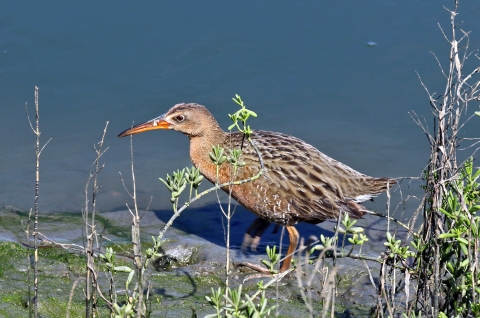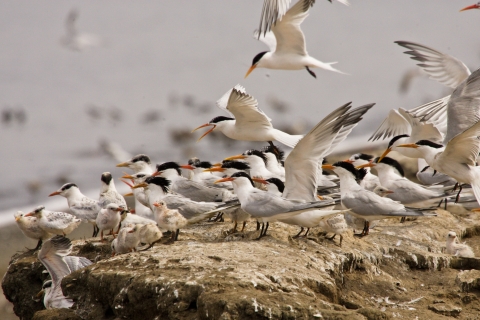San Diego Bay in Southern California is home to several threatened and endangered wildlife species who depend on dwindling remnant coastal habitats including mudflats and salt marshes. The light-footed Ridgeway’s rail, California least tern and salt marsh salt marsh
Salt marshes are found in tidal areas near the coast, where freshwater mixes with saltwater.
Learn more about salt marsh bird’s-beak are among those that have been most impacted by the loss of this habitat; but there’s hope for these species near the U.S.-Mexico border. Soon, they will have an additional 125 acres of coastal wetlands habitat because of the Otay River Estuary Restoration Project.
On October 21, 2022,Poseidon Resources (Channelside) LP and the U.S. Fish and Wildlife Service announced the groundbreaking of the Otay River Estuary Restoration Project. The project will create, restore and enhance coastal wetland and salt marsh habitat in the San Diego Bay National Wildlife Refuge to protect native fish, wildlife and plant species.
“The Otay River Estuary Restoration Project is yet another example of what we can achieve when private, state and federal partners come together on a common goal,” said Andy Yuen, Project Leader for San Diego Bay National Wildlife Refuge. “Restoring our coastal environment will protect endangered wildlife and ensure we have a healthy ecosystem that can be enjoyed for generations to come.”
The Otay River Estuary Restoration Project will restore former and active salt ponds located within the San Diego Bay National Wildlife Refuge with an estimated 300,000 cubic yards of soil to restore the intertidal habitat back to its natural condition. In doing so, the project will create new foraging, nesting and breeding habitat for colonial nesting seabirds, migratory shorebirds, waterfowl and salt marsh-dependent species – all of which contribute to a healthy ecosystem for the San Diego region.
“It is more important now than ever to protect and preserve our coastal environment,” said George Dowden, President of the Friends of San Diego Wildlife Refuges. “We applaud Poseidon and the U.S. Fish and Wildlife Service for their continued dedication to preserving our beautiful coastline and promoting environmental sustainability.”
In 2008, Poseidon committed to developing and implementing a Marine Life Mitigation Plan to mitigate environmental impacts from the Claude “Bud” Lewis Carlsbad Desalination Plant, a private-public partnership between Poseidon and the San Diego County Water Authority to provide the San Diego region with a sustainable source of high-quality drinking water. Since this time, Poseidon has worked diligently with the Service, California Coastal Commission, Port of San Diego, San Diego County Water Authority, the Regional Water Quality Control Board, and other key partners to deliver the Otay River Estuary Restoration Project, which fulfils the mitigation commitment.
“This project builds upon the Carlsbad Desalination Plant’s long history of preserving our coastal environment,” said Poseidon President Sachin Chawla. “We remain committed to being great stewards of the environment and helping San Diego achieve water independence.”
The Carlsbad Desalination Plant is the first of its kind to comply with the California Ocean Plan Amendment, which advances the use of ocean water as a reliable supplement to traditional water supplies while protecting marine life and water quality. Operational since December 2015, the Carlsbad Desalination Plant has provided 50 million gallons of fresh, desalinated drinking water per day to the region, accounting for 10% of San Diego's water supply. The Carlsbad Desalination Plant is the largest, most technologically advanced and energy-efficient seawater desalination plant in the Western Hemisphere and is the result of a 30-year Water Purchase Agreement between the San Diego County Water Authority and Poseidon Water for the entire output of the plant.
The Otay River Estuary Restoration Project is expected to be completed in approximately three years. The majority of restoration work will be performed between Oct. 1 and Feb. 15 to accommodate bird nesting season at the refuge.
For more information, please visit the project website at carlsbaddesal.com/mitigation and https://fws.gov/story/otay-river-estuary-restoration-project.






